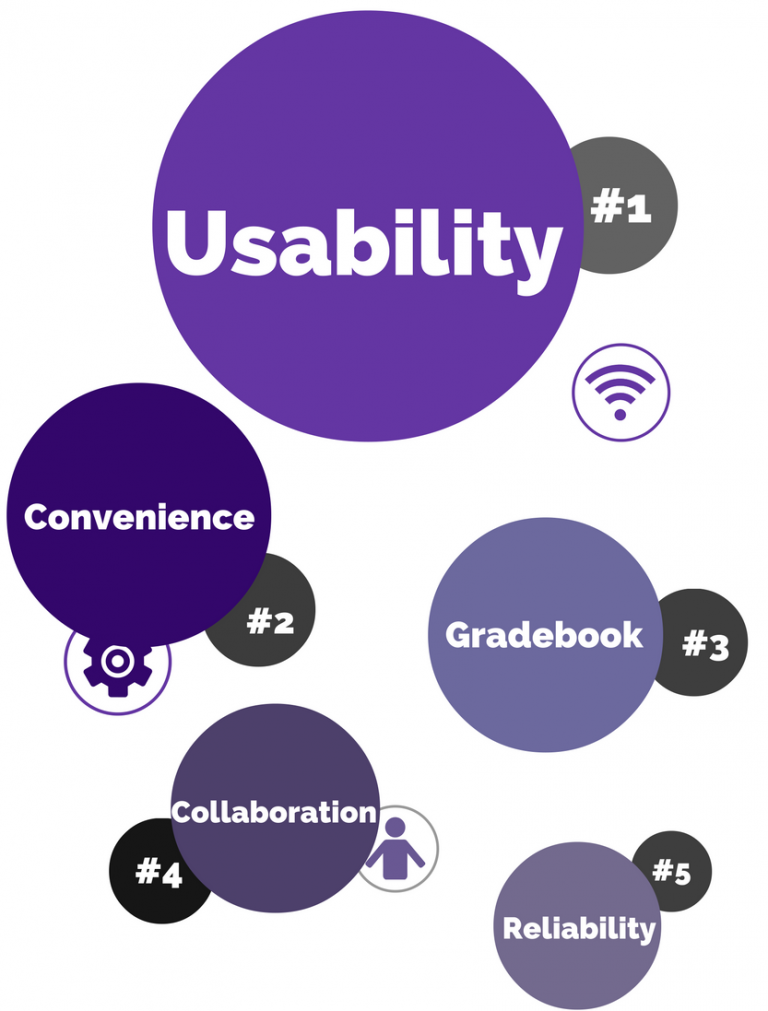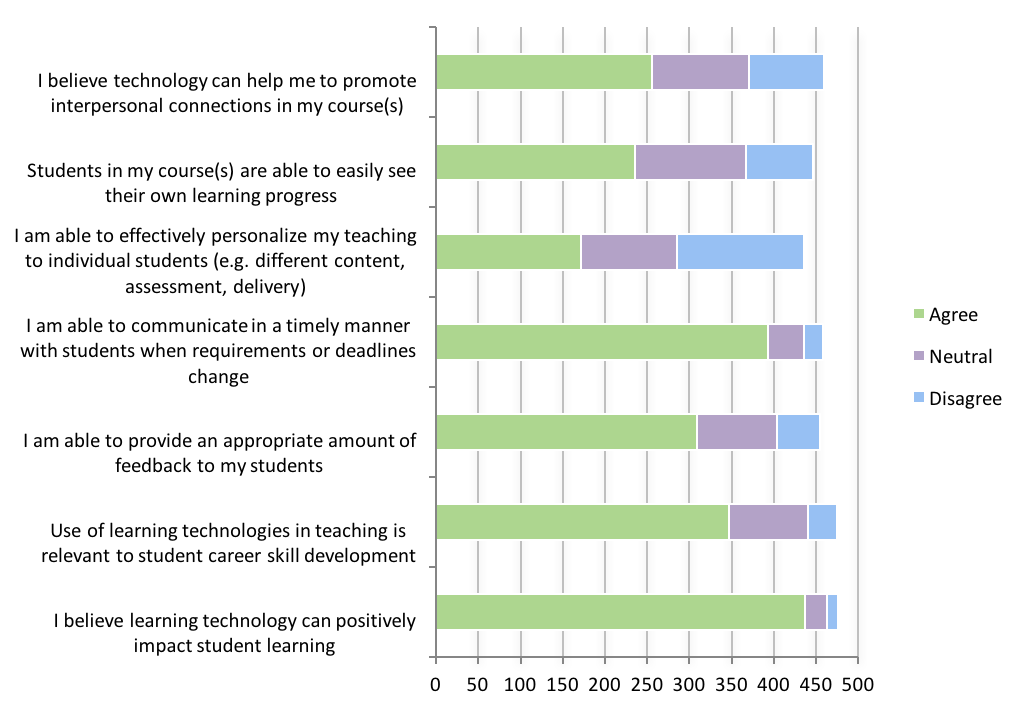Between August and December 2016, as part of the needs assessment phase of the Learning Technology Environment (LTE) Renewal project, instructors and students engaged their peers to determine each group’s priorities for replacing Connect, the previous platform for online courses at UBC. The team gathered feedback using a variety of methods, including surveys, focus groups, town halls, and interviews.
Summary of Results
The analysis of all of the data collected during the needs assessment phase showed that usability was the top priority for UBC faculty and students. Faculty and students also both reported that convenience and reliability were among their top five priorities.
Faculty Priorities
Faculty identified usability, convenience, the gradebook, collaboration, and reliability as their top priorities.

Faculty definitions of these terms
Definition: When there is a simple, user-friendly, easy-to-learn interface that allows users to efficiently perform their desired tasks.
- "Simple and intuitive to use"
- "Quick and easy to update, intuitive, not complicated"
Definition: When online course content (e.g., lecture notes, videos, library resources, and other instructor-directed content) can be accessed, added, and edited at any time.
- "Simple and efficient upload, storage, and organization of digital files and resources (i.e. customizable folder structure, drag and drop)"
- "Making content available any time, any place; allowing students to optimize their path through the maze of material, focusing on elements that they individually need most"
Definition: Ability to monitor and share students' learning progress within the course (e.g., grades, written feedback, etc.).
- "Students do practice tests and assessments online which are automatically and immediately graded (immediate feedback)"
- "Flexible gradebook – be able to calculate more complex indices of performance. E.g. put together different measures, or parts of different measures into a score"
Definition: Ability to support and promote knowledge exchange between students, between students and the instructor, and between students and people external to the course.
- "Promote peer to peer knowledge exchange"
- "Students post and share data collected in class (during lab time) for further analysis by all"
- "Students need to be able to write and see each other writing in real time"
Definition: When the system is stable and responsive.
- "Needs to be able to handle peak load demands"
Faculty Survey Results
The faculty version of the survey asked UBC Vancouver and UBC Okanagan faculty about their current and desired uses of technology to support teaching and learning and about aspects of the current learning technology environment that need improvement.
In total, 478 faculty members responded to the survey. One of the primary goals for the survey was to determine faculty members’ functional and pedagogical requirements for UBC’s learning technology environment. Faculty members’ current and desired uses of learning technology are outlined in the table below.
Faculty: Current and desired uses of technology

The survey also asked faculty members for their view on technology-supported classroom experiences. Faculty responses are outlined in the table below.
Faculty: Technology-supported classroom experiences

Student Priorities
Students identified usability, convenience, reliability, collaboration, and a seamless experience as their top priorities.

Student definitions of these terms
Definition: When there is a simple, user-friendly, easy-to-learn interface that allows users to efficiently perform their desired tasks.
- "It must be easy or easy to learn and intuitive"
Definition: When online course content (e.g., lecture notes, videos, library resources, and other instructor-directed content) can be accessed any time and there is flexibility regarding both students' learning process and schedules.
- "Technology gives me work/life/school balance as I do not have to organize extra travel to be in a class physically and at a specific date/time. I have so much flexibility. Online learning is the reason I chose UBC."
Definition: When the technology is reliable without defects or glitches so students can consistently rely on the program to do all tasks expected of them.
- "It needs to be there when I need it"
Definition: Ability for students to have discussions and work with each other, instructors, and people external to their course through peer instruction, group activities, and other ways to support coming up with answers together.
- "Opportunities for collaboration and connection via the internet with other students, with faculty, and thinkers both within my academic community and beyond it"
Definition: When there is a central place for accessing course materials/grades/due dates etc. in one place, information is not repeated in multiple places, and there is consistency across courses with respect to set-up and layout.
- "All on one site rather than spread out across multiple platforms"
Student Survey Results
UBC students from the Okanagan and Vancouver campuses were invited to take a student-focused version of the survey. In total, 1,159 students participated, providing feedback on how they currently use technology, how technology can best support learning, and what they would like to see change for the better. Importantly, over 90% of student respondents agreed that technology could positively impact their learning.
Better understanding how students use (and would like to use) technology to support their learning was a key objective for the survey. Students’ current and desired uses of learning technology are outlined in the table below.
Students: Current and desired uses of technology

The survey also asked students about the use of technology to support their classroom and learning experiences. Students responses are outlined in the table below.
Students: Classroom and learning experiences supported by technology
